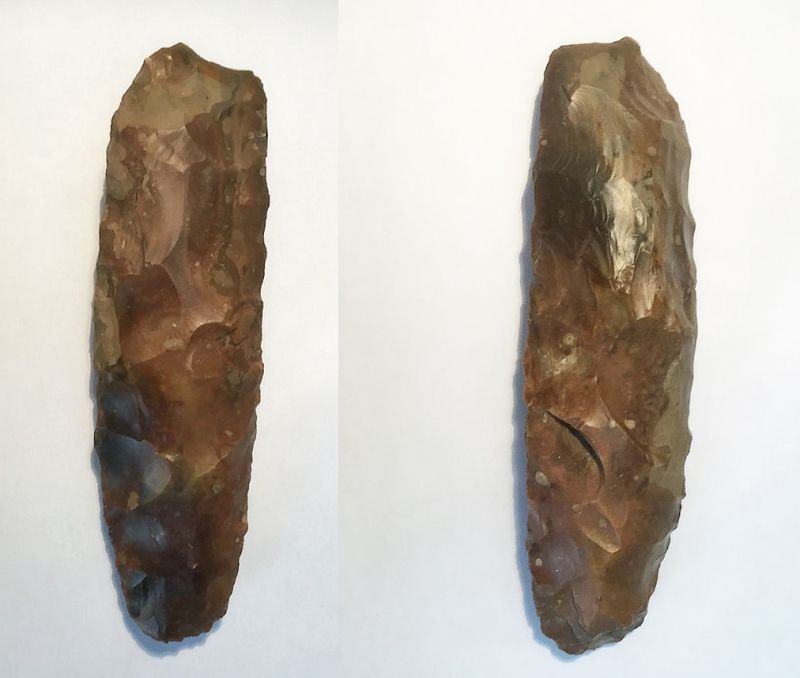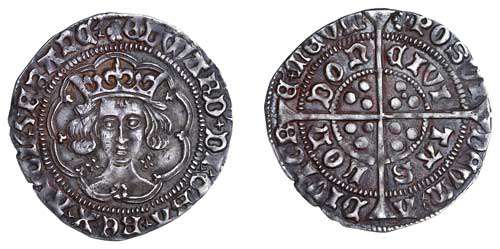Neolithic Thames Pick
Mill Cottage, Peldon, stands on the road leading to the Strood causeway linking Mersea to the mainland. It stands adjacent to Mill House, which in turn, stood next to Wents Mill, and both houses still stand although the mill itself was demolished around 1906. Bryan Puxley, who was born in Mill Cottage and whose ancestor, James Puxley, married a Peldon girl in 1832, got in touch to tell us about a Neolithic Thames Pick he found in the early 1960s and sent us photographs.
It was found in 1960, in the field behind Mill Cottage whilst pea-picking. Colchester Castle Museum stated that it was a 'Neolithic Thames Pick dated 2000BC'. My understanding also is that someone (presumably from the Museum) had a further look around the field and found no more artefacts.

Red Hills
All around the coastal marshes locally, there is evidence of Red Hills, the result of early salt-making. Along Pyefleet and Strood channels the distinctive red earth of these Red Hills can still be seen - over the years many local farmers have reported seeing their remains when ploughing - and it is estimated that there are over 300 sites of these early salt works in Essex. One notable example can be seen within metres of the Strood on the Langenhoe side looking eastwards. Referred to as the 'Burnt Hill' it is raised above the rest of the marsh and is rarely inundated by water, so is now an overgrown mound with scrub and hawthorn
It is thought the salt-panning industry was at its height in the late Iron Age and early Roman period (the Iron Age extended from 800 BC to 43AD and was followed by the Roman invasion). Clay-lined tanks were made and filled by the incoming tide, this allowed some natural evaporation but also allowed impurities to settle, the salt water was then placed in rough clay pots or pans which were stood on pedestals and gently heated over a fire. Many of these receptacles broke in the process and along with the tell-tale fired red soil many fragments of this broken pottery can be found, often referred to as briquetage.
Russell Martin, farmer of Moor Farm, tells me there are Red Hills on his farm and between a foot and 18 inches down in the fields there is an extensive layer of oyster shells. A local historian believes the site may have been a temporary summer camp for Romans involved in the salt workings.
The first archaeological investigation of Peldon's Red Hills was in 1879 and many subsequent reports have been
written about the Red Hills found all along our East coast. Most notable is the report by Kay de Brisay. In her
report entitled The Excavation of a Red Hill at Peldon [ Note 1 ], she details the Colchester Archaeological Group's excavation and findings at a dig over 45 years ago.
Where the road runs West from the Peldon Rose, the field slopes southwards towards the marsh and the sea wall, (which was originally built over 300 years ago). It was on the seaward side of the sea wall that the excavation took place. The archaeologists, who worked at weekends over a three year period between 1973 and 1976, found that the Red Hill straddled the sea wall and extended into the salt marsh known as Bonner's Saltings. The Red Hill, situated to the east of Shell Bungalow, covered an oval area 56m x 35m and evaporation tanks , hearths ,briquetage and, incidentally, human remains, were found. The resulting detailed and illustrated report by Kay De Brisay is available from the library, Mersea Museum or on-line. Local resident, Kath Evans, who lived close to the excavation and assisted the dig was an amateur archaeologist and in August 1988 was featured on the BBC's Countryfile talking about the Red Hills.
The Bullock tomb
Samuel Bullock was a wealthy landowner and it is believed lived in Brick House Farm at the end of the 1700s. He died in 1814 aged 78.
As Kay Gilmour wrote, he owned and farmed most of the land locally, employing most of the labour
his family connections with Peldon dated back to Commonwealth if not Tudor times. He owned Peldon Hall, Newpotts,
Sampsons, Eley's, Games and all the cottages and land that went with them.
Peldon in Essex A - Village Over the Marshes [ Note 2 ]
Upon his death, Colchester Gazette noted he was in an advanced age, universally respected and Kay Gilmour
surmised he must have enjoyed one of the largest funerals Peldon has ever seen.
In his will, Samuel requested that he may be interred in the vault in Peldon Church Yard by the side of my late
beloved wife who is buried there. His wife, Sarah, whom he married in 1763, was buried in this vault in 1777 along with several children who died young. Their adult son, also called Samuel, who predeceased his father, is buried there as is Samuel Senior's daughter and heiress, Jane Creek, who died in 1823 and, as far as we know, was the only child to outlive her father.
Early this century the Bullock table-top tomb collapsed.
The collapse enabled Colchester Archaeological Group to examine the vault and produce a report which appears in the
Colchester Archaeological Group magazine Vol 51 2011. The article,A Watching Brief in Peldon Churchyard by Don Goodman [ Note 3 ] states the brief was to look at the backfill from the time of the vault's building in the hopes it might reveal evidence of the earlier
Saxon church built there. There were many older bones and two skulls from previous burials and the conclusion was
the builders had little or no respect for earlier burials in the vicinity of the new vault they were building.
No Saxon pottery was uncovered although there were two Roman pottery sherds. Inside, the Bullock family's vault was
under water. It revealed three brick partitions running east/west and as was expected contained much rotted coffin
material and skeletons. One coffin had a highly decorated coffin plate on the lid possibly of copper or brass. Sadly, this table- top tomb with its lengthy inscription, naming many members of the Bullock family, is overgrown with ivy and has never been restored. Fortunately, the graveyard book made by the Essex History Society in 1999 (of which there is a copy in the church) gives a transcription of the incomplete two hundred year old inscription.
Coin Hoard
In A Coin Hoard from Peldon Churchyard, an article in the journal of Essex Archaeological Society Vol 9 1977 [ Note 4 ], Warwick Rodwell describes a hoard of 14 silver medieval coins in varying condition found as a group in the graveyard of St Mary's, Peldon around 1968.
Upon investigation, Warwick visited the owner living in the Kelvedon /Rivenhall area and was able to find details of the find, taking some rubbings of the coins and some photographic slides which are now kept in the Department of Coins and Medals in the British Museum.
The hoard was discovered at a depth of four feet during the digging of a grave a little to the east or south east of the church porch. Five of the coins were groats and nine were pennies. The groats were in good condition but three of the pennies were worn smooth; all of the pennies had been clipped. (Clipping involved small amounts of the coin's precious metal being shaved off. The coin would still retain its face value but clippings could be melted down and made into new coins). The gravedigger said the coins were found with many bones but it was uncertain as to whether the money had been buried along with a body, dropped by a fifteenth century gravedigger or mourner, or hidden by someone intending to retrieve the coins at a later stage. It is estimated in the report that the level of the ground may have risen by as much as two feet over the period of five hundred years since the coins were buried.
An expert studied eleven of the coins from rubbings taken by Mr Rodwell and they were found to come from the reigns of Edward I (reigned 1272-1307) Edward II (reigned 1307 - 1327), and either Edward III (reigned 1327 - 1377) or Richard II (reigned 1377 - 1399). The latest coin was a groat issued in 1467 - 1468 during the reign of Edward IV (reigned 1461 - 1470) making 1467/8 the earliest the hoard could have been deposited in the ground.
More detail can be obtained from the Essex Archaeological Society article, available on-line.
I am not a coin expert but the picture below of what is called a 'light coinage groat' from 1464 - 1465, minted in London during the reign of Edward IV, probably resembles the Edward IV groat that was found!

Elaine Barker
Peldon History Project
Sources
Note 1. The Excavation of a Red Hill at Peldon by Kay de Brisay. Colchester Archaeological Group Vol. 17 1974.
caguk.net/wp-content/uploads/2013/01/Bulletin-17.pdf
See also "Red Hills of Essex", published by Colchester Archaeological Group. ISBN 0 9503905 18
Available from your Library, to view at Mersea Museum, or to buy at
caguk.net
Note 2. Peldon in Essex - A Village over the Marshes by Kay Gilmour. Available in the Local Studies section of Colchester Library
Note 3. Colchester Archaeological Group Vol 51 2011 "A Watching Brief in Peldon Churchyard". See
caguk.net/wp-content/uploads/2018/01/Bulletin-51-2011.pdf
Note 4. Essex Archaeology and History Vol 9 1977 "A Coin Hoard from Peldon Churchyard". See
esah1852.org.uk/all-published-contents/item/109-3rd-series-vol-9-1977-contents-list
|